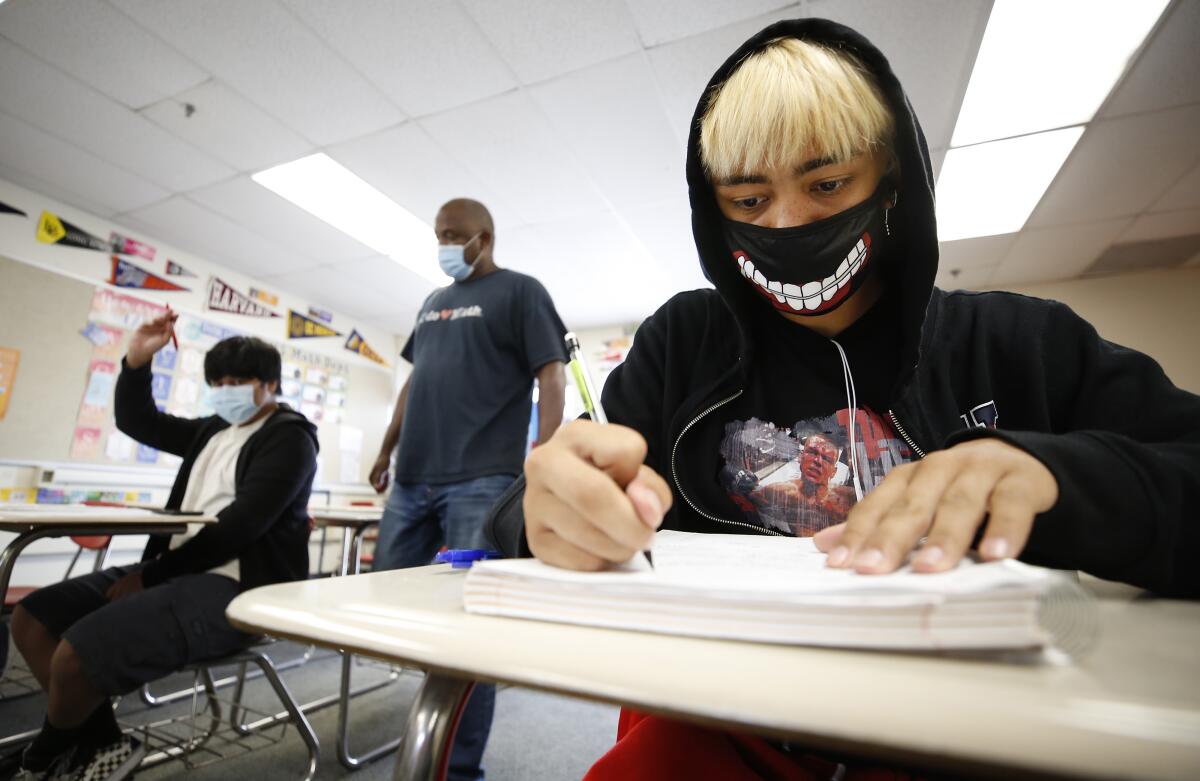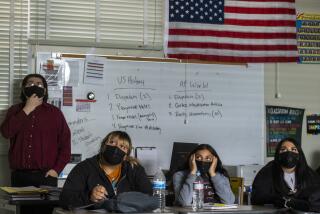Editorial: Delta variant put school reopening in a quandary. Here’s how to fix it

- Share via
The start of California’s new school year hasn’t been going as we’d all hoped. If there’s any “fault” involved here, it lies in the ability of viruses to mutate — in this case, the easily transmitted Delta variant of the coronavirus spread so quickly it left school administrators little time for planning.
An immediate surge in reported cases was expected, as students and staff were suddenly being tested in large numbers. But there also have been some outbreaks as infections have spread within classrooms and campuses.
That has meant a lot of absences from school for infected students and any classmates and staff members who have come into close contact with them. The sheer number of cases, combined with a restrictive new state law on how to educate students at home, has meant that these students aren’t getting the education they need and that schools could be penalized unfairly by the withholding of daily-attendance funding for being unable to provide the required teachers for all of them. Quick action is needed at both the state and local levels.
In the Los Angeles Unified School District alone, 6,500 students were sent home during the first week . In part, that’s because Los Angeles County has even stricter rules than the state. It requires unvaccinated or partly vaccinated people who have been in close contact with an infected person to quarantine for 10 days — and since those younger than 12 cannot be vaccinated, elementary schools are especially at risk of being emptied as a result of coronavirus cases. The state, however, allows unvaccinated students and staff members who have been exposed to remain on campus if both the infected person and the close contact were masked during the exposure. There are voices of dissent on both policies, saying they should be loosened.
For now, though, a tight rein on school health makes sense. We don’t know the full shape of the variant and how it will behave in the confines of a classroom. At least one study indicates that it is not just more contagious but also could result in more serious illness, at least among the unvaccinated. Children are less likely to become seriously ill from COVID-19 in general, but it’s unclear what those numbers will look like if many of them are infected. The bigger danger is that they can bring the variant home to their families and communities.
Easing up on restrictions could be counterproductive as well, frightening parents into pulling their children back from campus for some kind of distance learning. The best thing we can do for students is keep schools open, and that means keeping them and their teachers safe. A single student or staff member could theoretically be in close contact with infected people on campus multiple times during the school year, leading to many weeks in quarantine.
Kids also need to be educated with as little disruption as possible, and a state law passed to prod parents to send their children back to school has had the unintended result of making that difficult. It requires that, instead of distance learning, students go into independent study, which is what it sounds like: Instructors hand out packets of work that students complete on their own. It’s perfect for child actors, but it doesn’t work for kids who need stable instruction that keeps them up with their class.
The state law created a sort of hybrid system in which students also are supposed to receive some kind of daily contact with a teacher. Districts that fail to do so could lose funding for those students. The problem is, there aren’t nearly enough teachers to go around, and it’s disruptive for students to go back and forth
On Monday, Los Angeles Unified came up with the best solution — at least, the best educationally. The question now is whether the state will accept this as “independent study.”
When several students from a classroom are quarantined, their classes will be livestreamed using existing audiovisual equipment. When an entire class is shut down, the teacher will conduct class via videoconference, similar to the remote learning of last year but with a regular school schedule.
It’s a reasonable approach and should be adopted statewide, along with the ability to hire and quickly train uncredentialed but educated personnel — such as new college graduates — to tutor and guide students who are quarantined.
For its part, the state needs to amend existing law to ensure that schools aren’t penalized if they’re taking steps to continue teaching students in a way that is as normal as possible. Not that it was legislators’ fault, either; the independent-study law had the right intention of making in-person instruction the default.
The Delta variant is testing our capacity for nimble thinking and action. Schools are among the places where that’s most needed.
More to Read
A cure for the common opinion
Get thought-provoking perspectives with our weekly newsletter.
You may occasionally receive promotional content from the Los Angeles Times.










